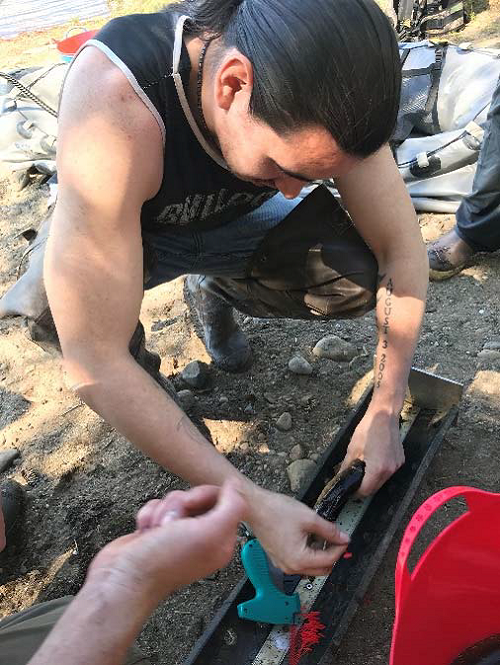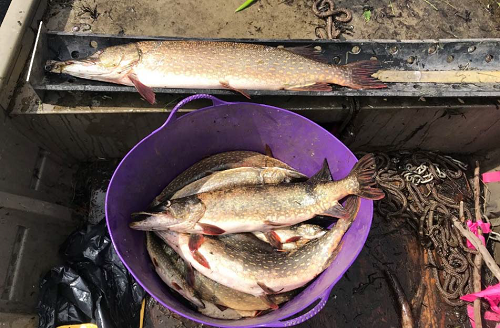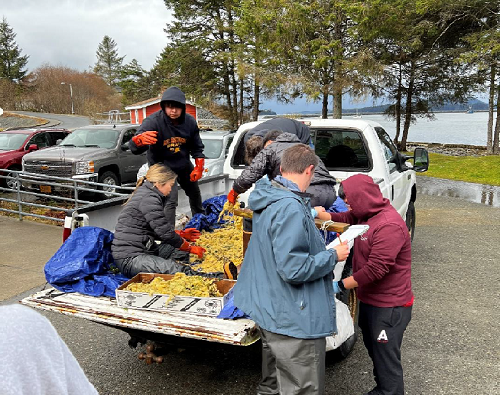Subsistence refers to the harvest, use, and sharing of wild, renewable plant and animal resources for food, shelter, fuel, clothing, tools, or transportation as part of long-standing practices that are an important foundation of Alaska Native cultures. In Alaska subsistence hunting, fishing, and gathering is protected and regulated federal law under Title VIII of the Alaska National Interests Land Conservation Act (ANILCA), which accords a priority for harvesting fish and wildlife by rural residents over recreational/sport and commercial users on federal lands. The State of Alaska also manages subsistence fishing and hunting for State and privately-owned lands, albeit all Alaska residents are eligible under these regulations.
“Our way of life” is how Alaska Natives describe their traditions of subsistence hunting, fishing, and gathering. Protecting these activities helps to preserve indigenous cultures, share traditional ecological knowledge, and connect Tribal elders and youth. Wild subsistence foods are healthier and more economical for Alaska Native people than processed store-bought foods, which must be shipped into rural communities at great expense.
Protecting subsistence activities also supports the economies of Alaska Native communities. Subsistence hunting, fishing and gathering constitute a local economy operating alongside the cash economy. A healthy balance between these two economies, including a sustainable subsistence economy, is critical to the ongoing resilience of Alaska Native communities.
Subsistence Use Programs and Funding
The Bureau of Indian Affairs (BIA) Alaska Regional Office Subsistence Branch plays a key role in Federal and State agencies’ management of subsistence, and advocates for Alaska Native subsistence rights through the Federal Subsistence Board. The Subsistence Branch also provides funding, guidance, and technical assistance to Tribes, Alaska Native villages, and Alaska-based inter-Tribal organizations on managing natural resources for subsistence use.
The BIA Division of Natural Resources Branch of Fisheries, Wildlife and Recreation (BFWR) provides competitive funding for eligible Alaska-based inter-Tribal organizations to protect, conserve, use, enhance or restore natural resources for subsistence uses with a goal of obtaining a Tribal reserved right to subsistence resources allowing true co-management with State and Federal partners.
Who Manages Land in Alaska?
Subsistence activities in Alaska are managed by both the U.S. Federal government and the State of Alaska. This affects Alaska Natives as traditional hunting, fishing, and gathering areas used by Tribal members lands may encompass different jurisdictions. Thus, the regulations governing subsistence harvests will vary depending on the status of the land or waters where these activities take place.
The U.S. government manages subsistence fishing and hunting on federal public lands and waters under the Title VIII of ANILCA. Management authority is delegated to the Federal Subsistence Board, an eight member board composed of the Regional Director of the BIA, State Director of the Bureau of Land Management, Regional Director of the National Park Service, Regional Director of the U.S. Fish and Wildlife Service, Regional Forester of U.S. Forest Service, and three members of the public (including the Chair) representing rural Alaskans who are appointed by the Secretaries of the Interior and Agriculture.
The State of Alaska manages subsistence use of fish and wildlife on State public lands and privately-held Tribal lands (including Alaska Native Corporation lands and Native allotments) through the Alaska Department of Fish and Game.
How to Apply for Alaska Subsistence Program Funding
BFWR has sent letters to eligible Alaska inter-Tribal organizations to apply for 2024 subsistence project funding. Completed applications must be submitted to the BIA Alaska Regional Office by May 13, 2024.
Eligible inter-Tribal organizations may submit proposals to develop and implement collaborative subsistence management partnerships with the federal agencies responsible for implementing the Title VIII of the Alaska National Interest Land Conservation Act (ANILCA), on federal lands in Alaska.
Each eligible inter-Tribal organization may request between $150,000 and $750,000 in project funding in their application (not including Tribal indirect rate). Eligible inter-Tribal organizations may submit more than one proposal, but only one proposal will be awarded funding.
Project applications are scored according to published eligibility and ranking criteria. Final funding amounts are determined by the amount of funding available in a given fiscal year, and the degree to which proposals aligns with the selection criteria.
For additional information on the program and application process, please contact Glenn Chen, Subsistence Program Manager by phone at (907) 350-4102 or email at glenn.chen@bia.gov.
Previously Funded Alaska Subsistence Program Projects
Native Village of Tyonek

The Native Village of Tyonek Environmental Director tagging pike for mark recapture data.
The Native Village of Tyonek established a local taskforce and began the Tyonek Area Watershed Invasive Pike Eradication Initiation project in 2018. The purpose of the project is to eradicate pike that threaten subsistence resources, such as the native salmon populations, on the western Cook Inlet. In 2018 alone, the Native Village of Tyonek reported the return of salmon rearing and spawning in Threemile Creek as a result of removing 1,335 pike from the creek drainage.

Successful pike removal using gillnets.
Sitka Tribe of Alaska

Tribal staff and high school students processing and weighing herring eggs for distribution to Tribal citizens during the April 2022 Herring Camp.
Since 2014, the Sitka Tribe of Alaska has hosted a month-long youth engagement program each spring called Yaa Khusgé Yaaw Woogoo (“Knowledge of Herring”). The project focuses on local natural resource management and traditional ecological knowledge, as well as introduces Tribal youth to potential careers in ecology, marine biology, and natural resource management.
During the 2022 Herring Camp, high school students participated in hands-on anatomy and dissection lessons, went on a boat trip to two research stations to observe animal behavior in the field, and performed microscopy to identify harmful species of phytoplankton. At the end of the camp, students analyzed their findings and related their work to local natural resource management issues and subsistence practices.
Additional Information
Additional Resources
Contact Us
Albuquerque, NM 87104


